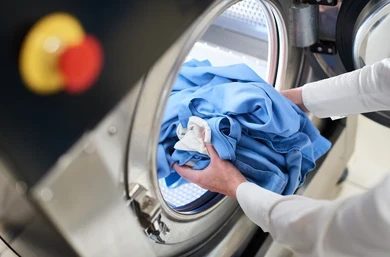The dry cleaning solvents are solvents used in dry cleaning which are typically hydrocarbons, such as perchloroethylene (PERC), or glycol ethers, which are effective at dissolving oils, greases, and other substances that are difficult to remove with water. These solvents are also non-flammable, making them safe for use in the dry cleaning process.
Dry cleaning is a specialized cleaning process that uses solvents to remove dirt, stains, and other impurities from fabrics without the use of water. This method of cleaning is particularly useful for delicate fabrics that cannot withstand the rigors of traditional washing and drying methods.
The process of dry cleaning begins with the pre-treatment of stains and other blemishes on the fabric. This is done by applying a solvent-based cleaning solution to the affected areas, which helps to break down and dissolve the stain. The fabric is then loaded into a specialized cleaning machine that uses a combination of solvents and mechanical action to remove dirt and other impurities from the fabric.
After the cleaning process is complete, the fabric is dried using a combination of heat and air. This helps to remove any remaining solvent from the fabric and ensures that the garment is fully dry before it is returned to the customer.
Dry cleaning is a popular method of cleaning for a wide range of fabrics and garments, including suits, dresses, and other formal wear. It is also commonly used for cleaning household items such as curtains, drapes, and upholstery.
When choosing a dry cleaner, it is important to consider factors such as the quality of the cleaning process, the turnaround time for cleaning and delivery, and the cost of the service. It is also important to choose a dry cleaner that uses environmentally-friendly solvents and methods to minimize the impact on the environment.
Dry cleaning is a specialized cleaning process that uses solvents to remove dirt, stains, and other impurities from fabrics without the use of water. This method of cleaning is particularly useful for delicate fabrics and is a popular choice for formal wear and household items. When choosing a dry cleaner, it is important to consider factors such as the quality of the cleaning process, the turnaround time, and the environmental impact of the service.
The Importance and Uses of Dry Cleaning Solvents

Dry cleaning is a process of cleaning clothes and textiles using non-aqueous solvents, such as perchloroethylene (PERC) and hydrocarbons. While dry cleaning has become an essential service for individuals and businesses alike, the solvents used in the process have a significant environmental impact.
The use of dry cleaning solvents has been found to contribute to air pollution and soil contamination, leading to serious environmental consequences. PERC, which is the most commonly used dry cleaning solvent, has been classified as a toxic air contaminant by the California Air Resources Board due to its potential to cause cancer and other health problems. In addition, PERC has been found to contaminate groundwater and soil, leading to long-term environmental damage.
An’s dry cleaning is a popular dry cleaning service that uses PERC as its primary solvent. While this solvent is highly effective at cleaning clothes and textiles, its environmental impact cannot be ignored. An’s dry cleaning can take steps to minimize its impact on the environment by implementing measures to reduce the amount of solvent used, properly disposing of the solvent, and exploring alternative cleaning methods.
One way An’s dry cleaning can reduce its impact on the environment is by investing in newer, more efficient dry cleaning machines. These machines use less solvent and are better at capturing and containing the solvent, reducing the amount of emissions released into the air. Additionally, An’s dry cleaning can explore alternative solvents that are less harmful to the environment, such as GreenEarth or wet cleaning methods that use water-based solvents.
Proper disposal of the solvents used in dry cleaning is also crucial for minimizing their impact on the environment. An’s dry cleaning can ensure that its PERC is disposed of in a safe and environmentally responsible manner, such as through recycling or proper hazardous waste disposal methods.
Read Also: The Ultimate Solution for Plastic Waste
The environmental impact of dry cleaning solvents cannot be ignored. While An’s dry cleaning is a popular and essential service, it has a responsibility to minimize its impact on the environment. By implementing measures to reduce the amount of solvent used, properly disposing of the solvent, and exploring alternative cleaning methods, An’s dry cleaning can help mitigate its impact and contribute to a cleaner and healthier environment.
Another way An’s dry cleaning can reduce its impact on the environment is by encouraging its customers to adopt sustainable practices. For example, it can offer reusable garment bags made from eco-friendly materials, which can significantly reduce the amount of plastic waste generated by the dry cleaning process. It can also educate its customers on the importance of choosing clothes made from sustainable materials and the impact of dry cleaning on the environment.
An’s dry cleaning can also consider implementing a closed-loop system, where the solvent is recycled and reused instead of being disposed of after each cleaning cycle. This can significantly reduce the amount of solvent required, minimizing the environmental impact.
Furthermore, An’s dry cleaning can conduct regular audits to ensure that its operations are in compliance with environmental regulations and guidelines. This can help identify any potential environmental risks and allow the company to take appropriate actions to minimize its impact.
An’s dry cleaning can consider offsetting its environmental impact by investing in carbon offset projects. Carbon offsetting allows companies to invest in projects that reduce or offset their greenhouse gas emissions, such as renewable energy projects or reforestation efforts.
An’s dry cleaning has a responsibility to minimize its impact on the environment. By implementing measures to reduce the amount of solvent used, properly disposing of the solvent, exploring alternative cleaning methods, encouraging sustainable practices, adopting a closed-loop system, conducting regular audits, and considering carbon offsetting, An’s dry cleaning can significantly reduce its environmental impact and contribute to a cleaner and healthier planet.
An’s dry cleaning can also engage in partnerships and collaborations with other companies and organizations that prioritize environmental sustainability. For example, it can partner with sustainable fashion brands to promote eco-friendly materials and offer sustainable dry cleaning solutions. It can also collaborate with environmental organizations to support initiatives that aim to reduce the environmental impact of dry cleaning.
An’s dry cleaning can educate its employees on the importance of environmental sustainability and encourage them to adopt sustainable practices in their personal lives. This can help create a culture of sustainability within the company, and employees can serve as ambassadors for sustainable practices within their communities.
An’s dry cleaning can also prioritize transparency and communication with its customers regarding its environmental impact and the measures it is taking to reduce it. This can include displaying information about its sustainability efforts in its stores and on its website, as well as providing regular updates on its progress towards environmental sustainability goals.
An’s dry cleaning has the opportunity to lead the way in promoting sustainable dry cleaning practices and minimizing its impact on the environment. By engaging in partnerships, educating its employees and customers, prioritizing transparency and communication, and continuously striving towards environmental sustainability goals, An’s dry cleaning can set an example for the industry and contribute to a more sustainable future.
Read Also: Concept and Strategy for Air Quality Management
An’s dry cleaning can also consider implementing a waste reduction and recycling program to reduce the amount of waste generated from its operations. This can include initiatives such as recycling hangers, reusing packaging materials, and minimizing the use of single-use items.
Additionally, An’s dry cleaning can participate in local and national environmental programs and initiatives, such as the Green Business Certification Program or the Environmental Protection Agency’s (EPA) Design for the Environment (DfE) program. These programs provide guidelines and resources for businesses to become more environmentally sustainable, and participation can help demonstrate An’s dry cleaning’s commitment to sustainability to its customers and the community.
An’s dry cleaning can also consider conducting a life cycle assessment (LCA) to identify the environmental impact of its operations from cradle to grave. An LCA can help identify areas where the company can make improvements and reduce its overall environmental impact.
An’s dry cleaning can encourage its suppliers and partners to adopt sustainable practices as well. For example, it can prioritize working with suppliers that use sustainable materials or have environmentally responsible practices.
An’s dry cleaning can take a holistic approach to minimizing its environmental impact. By implementing a waste reduction and recycling program, participating in environmental programs and initiatives, conducting a life cycle assessment, and encouraging its suppliers and partners to adopt sustainable practices, An’s dry cleaning can become a leader in environmental sustainability within the dry cleaning industry and contribute to a healthier planet.
An’s dry cleaning can also consider implementing energy-efficient practices to further reduce its environmental impact. This can include upgrading to energy-efficient lighting and equipment, installing solar panels, and implementing energy management systems to optimize energy usage.
An’s dry cleaning can prioritize water conservation by installing water-efficient equipment, such as high-efficiency washers, and implementing water-saving practices, such as using recycled water for certain cleaning processes.
An’s dry cleaning can also prioritize the use of eco-friendly cleaning products that are biodegradable and free of harmful chemicals. This can not only minimize the impact on the environment but also protect the health and well-being of its employees and customers.
An’s dry cleaning can engage with the local community and promote environmental sustainability beyond its own operations. This can include participating in local clean-up efforts, sponsoring environmental initiatives, and providing educational resources and materials to promote sustainable practices.
An’s dry cleaning can take a comprehensive approach to reducing its environmental impact by implementing energy-efficient and water-conservation practices, using eco-friendly cleaning products, and engaging with the local community.
By prioritizing environmental sustainability and continuously striving towards improvements, An’s dry cleaning can not only minimize its impact on the environment but also contribute to a healthier and more sustainable future for all.
Read Also: Sobe Drinks: Your Go-To Beverage for a Healthy Lifestyle

